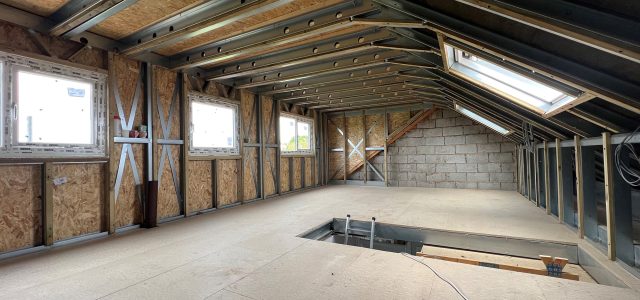
Ensuring Safe Loft Boarding: A Comprehensive Guide
Introduction
Loft boarding is a popular home improvement project that transforms an underutilised loft space into valuable storage or living area. However, safety should be the top priority when undertaking such a project. Improper loft boarding can lead to various hazards, including structural damage, fire risks, and personal injuries. This comprehensive guide aims to address the critical question: “Is loft boarding safe?” and provide insights into best practices for a secure and compliant installation.
Understanding the Risks of Unsafe Loft Boarding
Before delving into safety measures, it’s essential to understand the potential risks associated with improper loft boarding:
- Structural Integrity Compromise: Overloading the loft with excessive weight or failing to distribute the load evenly can lead to catastrophic consequences. Joist failure, ceiling collapse, or even structural damage to the entire building can occur if the load-bearing capacity of the loft is exceeded. This can not only result in costly repairs but also pose serious risks to the occupants’ safety.
- Fire Hazards: Covering loft downlights or electrical cables with boards or insulation can create fire risks due to heat buildup and potential electrical faults. Downlights, in particular, generate significant heat, and if they are covered or obstructed, the heat can build up, potentially igniting nearby combustible materials. Electrical cables, if compressed or damaged, can also pose a fire risk due to potential short circuits or overheating.
- Condensation and Damp Issues: Inadequate ventilation or insulation compression can lead to condensation, damp, and mould growth, compromising indoor air quality and potentially causing structural damage. When warm, moist air from the living spaces below enters the loft and meets cooler surfaces, condensation can form. If this moisture is not properly ventilated, it can lead to damp conditions and the growth of harmful mould, which can exacerbate respiratory issues and weaken the structural integrity of the loft over time.
- Personal Injuries: Working in confined loft spaces without proper safety gear or precautions increases the risk of falls, cuts, and exposure to insulation fibres or dust. Loft spaces are often cramped and poorly lit, making it easy to trip or fall, potentially leading to serious injuries. Additionally, handling insulation materials without proper protective equipment can result in skin irritation, respiratory issues, or eye injuries from airborne fibres or dust particles.
Ensuring Safe Loft Boarding: Best Practices
To mitigate these risks and ensure a safe loft boarding installation, it’s crucial to follow these best practices:
-
Assess the Loft Structure and Load Capacity
Before starting any loft boarding project, it’s essential to assess the structural integrity of the loft and determine its load-bearing capacity. This involves inspecting the condition of the joists, trusses, and other structural elements to ensure they are capable of supporting the additional weight of the boarding, insulation, and any stored items. Consult with a professional structural engineer or building inspector if necessary to obtain an accurate assessment and recommendations for reinforcement or load distribution strategies.
-
Use Raised Loft Boarding Systems
Raised loft boarding systems, such as LoftZone StoreFloor, are specifically designed to protect the insulation from compression and maintain proper ventilation. These systems create an air gap between the boards and insulation by using support structures like Loft Legs or Loft Leg XLs. This air gap not only prevents the insulation from being compressed, which can reduce its effectiveness, but also allows for adequate airflow to prevent condensation and damp issues. By maintaining the insulation’s performance and facilitating proper ventilation, raised loft boarding systems help ensure optimal thermal performance and a healthy indoor environment.
-
Properly Handle Electrical and Plumbing Components
Identifying and carefully working around any electrical cables, pipes, or downlights in the loft space is crucial for safety. Never cover or compress these components, as this can create fire hazards or disrupt essential services. Covering downlights can lead to heat buildup and potential ignition of nearby materials, while compressing electrical cables can cause insulation damage and increase the risk of short circuits or overheating. Similarly, obstructing pipes or vents can lead to plumbing issues or poor indoor air quality.
If necessary, seek professional assistance from qualified electricians or plumbers to safely reroute or protect these elements before proceeding with the loft boarding installation.
-
Maintain Adequate Ventilation
Proper ventilation is crucial for preventing condensation and damp problems in the loft space. Ensure that existing vents, such as soffit vents or ridge vents, are not blocked by the loft boarding or insulation. These vents play a vital role in allowing air circulation, which helps remove excess moisture and prevent the buildup of condensation.
If the existing ventilation system is inadequate or obstructed, consider installing additional ventilation systems, such as roof vents or mechanical ventilation units. Proper ventilation not only prevents damp issues but also helps maintain a healthy indoor air quality by removing stale air and pollutants.
-
Use Appropriate Safety Equipment
Working in loft spaces can be hazardous, especially when dealing with insulation materials and confined spaces. Always wear appropriate personal protective equipment (PPE), such as gloves, goggles, masks, and protective clothing, to minimise exposure to insulation fibres, dust, and potential injuries.
Insulation fibres can cause skin irritation, respiratory issues, and eye irritation if inhaled or exposed to the skin. Protective masks or respirators are essential to prevent inhalation of these fibres or dust particles. Additionally, gloves and protective clothing can help prevent skin irritation and cuts from handling insulation materials or sharp edges.
-
Follow Building Regulations and Seek Professional Assistance
Loft boarding projects may be subject to building regulations and require permits or inspections. These regulations are in place to ensure the safety and structural integrity of the building, as well as to protect occupants from potential hazards. Consult with local authorities or seek professional assistance from qualified contractors or building inspectors to ensure compliance and avoid potential legal issues or safety hazards.
Failure to comply with building regulations can result in fines, legal consequences, or even the need to undo the loft boarding work if it does not meet the required standards. Professional assistance can help navigate the complex regulations and ensure that the project is completed safely and in accordance with all applicable codes.
-
Consider Professional Installation
While DIY loft boarding is possible for those with the necessary skills and experience, it’s often advisable to hire professional installers, especially for complex or large-scale projects. Experienced professionals have the knowledge, tools, and expertise to ensure proper installation, adherence to safety standards, and provide valuable guidance throughout the process.
Professional installers are trained in safe work practices, such as using appropriate fall protection equipment, handling materials safely, and following proper installation techniques. They can also identify potential hazards or structural issues that may not be apparent to a homeowner, and recommend solutions to address them.
This table provides a clear and concise overview of the risks associated with unsafe loft boarding, the best practices to ensure safety, and additional tips to maintain a secure loft space.
| Risks of Unsafe Loft Boarding | Best Practices for Safe Loft Boarding | Additional Safety Tips |
| Structural Integrity Compromise: Overloading the loft can lead to joist failure, ceiling collapse, or structural damage. | Assess the Loft Structure and Load Capacity: Inspect joists, trusses, and other structural elements. Consult a structural engineer if necessary. | Use Appropriate Safety Equipment: Wear PPE such as gloves, goggles, masks, and protective clothing to minimise exposure to insulation fibres and dust. |
| Fire Hazards: Covering loft downlights or electrical cables with boards or insulation can create fire risks due to heat build-up and potential electrical faults. | Use Raised Loft Boarding Systems: Systems like LoftZone StoreFloor create an air gap between boards and insulation, preventing compression and ensuring proper ventilation. | Follow Building Regulations: Consult local authorities or professionals to ensure compliance with building regulations and avoid legal issues. |
| Condensation and Damp Issues: Inadequate ventilation or insulation compression can lead to condensation, damp, and mould growth. | Properly Handle Electrical and Plumbing Components: Identify and work around electrical cables, pipes, or downlights. Seek professional assistance if necessary. | Consider Professional Installation: Hire professional installers for complex or large-scale projects to ensure proper installation and adherence to safety standards. |
| Personal Injuries: Working in confined loft spaces without proper safety gear increases the risk of falls, cuts, and exposure to insulation fibres or dust. | Maintain Adequate Ventilation: Ensure existing vents are not blocked and consider installing additional ventilation systems if necessary. | Regular Inspections: Periodically inspect the loft space for signs of structural issues, damp, or other hazards. |
| Training and Awareness: Consider taking safety training courses, such as those on working at height, to improve knowledge and prevent accidents. |
Conclusion
Loft boarding can be a safe and rewarding home improvement project when undertaken with the necessary precautions and best practices. By understanding the risks, using raised loft boarding systems, maintaining proper ventilation, handling electrical and plumbing components correctly, wearing appropriate safety gear, following building regulations, and seeking professional assistance when needed, homeowners can transform their loft spaces into functional and secure areas without compromising safety or structural integrity.
Remember, safety should always be the top priority when undertaking any home improvement project, including loft boarding. By following these guidelines and exercising caution, you can enjoy the benefits of additional storage or living space while ensuring the well-being of your family and the longevity of your home.
